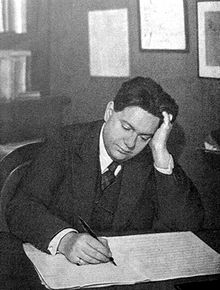La Création du monde
La Création du monde op . 81a is a ballet music by the French composer Darius Milhaud (1892–1974). A composition that takes up the elements of jazz was created for Rolf de Maré and his ballets Suédois . Fernand Léger designed the stage equipment for the ballet, which premiered in 1923.
Origin and premiere
Darius Milhaud came in 1920 in London with jazz in contact, had in 1922 during a stay in New York next Salon forms (played about by the Paul Whiteman -Orchestra) in Harlem and authentic New Orleans met and records of jazz labels Black Swan Records back taken to France. The order of Rolf de Maré , for which he led Ballets Suédois a ballet music to compose, offered him the opportunity to put these experiences compositionally.
The ballet scenario for a Création du monde ("Creation of the World") based on African myths came from Blaise Cendrars . Fernand Léger designed an archaic décor inspired by African folk art for the premiere on October 25, 1923 at the Théâtre des Champs-Élysées in Paris (choreography: Jean Börlin ): three 8-meter statues of gods dominated the stage, protected by plants, animals and people were created, portrayed by dancers in fantastic costumes.
plant
Cast and duration of performance
When casting La Création du monde , Milhaud used the instruments of the 1922 jazz musical Liza by Maceo Pinkard , which he had heard in Harlem. 17 solo instruments are planned: 7 woodwinds (2 flutes , oboe , 2 clarinets , bassoon, alto saxophone ), 4 brass instruments ( horn , 2 trumpets , trombone ), piano , percussion and 4 strings (2 violins , violoncello , double bass ). The role of the omitted viola is partly taken over by the saxophone.
An alternative version for piano and string quartet (op.81b) was premiered in Baden-Baden in 1927 .
The performance lasts around 17 to 20 minutes.
music
According to the ballet scenario, Milhaud's music consists of 6 interlocking movements.
- Overture: Calm, melancholy prelude dominated by the saxophone solo, melodically reminiscent of Johann Sebastian Bach (with the curtain closed).
- Le chaos avant la création: a depiction of the chaos before creation, dominated by rumba rhythms and a jazz fugue . Three figures of gods stand up, hold advice and perform incantations.
- La naissance de la flore et de la faune: flute and oboe solos. Dancers representing plants and animals slowly rise.
- La naissance de l'homme et de la femme: Fast tempo, determined by syncopated melodies in various scoring. The animals dance around the gods. After renewed incantations, man and woman break away from the mass of animals.
- Le désir: Very fast tempo, saxophone and clarinet solos over ostinati . Orgiastic dance of the first human couple.
- Le printemps ou l'apaisement: Calm tempo, recurrence of thematic forms from earlier movements. End of the round dance, beginning of spring.
literature
- Bohumír Mráz: Fernand Léger . Gondrom, Bayreuth 1980, ISBN 3-8112-0103-4 . Pp. 40, 42.
- Hans Renner, Klaus Schweizer: Reclam's concert guide for orchestral music . Philipp Reclam jun., Stuttgart 1976, 10th edition, ISBN 3-15-007720-6 . Pp. 673/674.
- Markus Munzer-Dorn (Red.): Program booklet symphony concert February 13, 1990. Ulmer Theater.
- Ulrich Konrad : Cosmogonie nègre. African world creation myths in Fernand Légers and Darius Milhaud's ballet La création du monde (1923) . In: Dorothea Klein (ed.), The Creation of the World - Old and New Creation Myths, Würzburg 2012 (= Würzburg Lecture Series), pp. 115-134.
Web links
- Information about La Création du monde at Klassika.info
- Comparison of interpretations of La Création du monde on September 29, 2011 on Radio DRS2
- Notes to La création du monde (PDF, 43 kB) at Williams College (Engl.)
- Academic Orchestra Erfurt La Création du monde op.81 (1923) (The Creation of the World)
